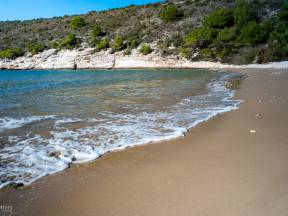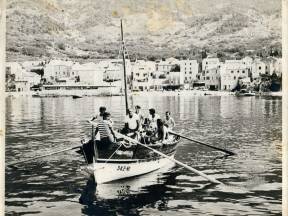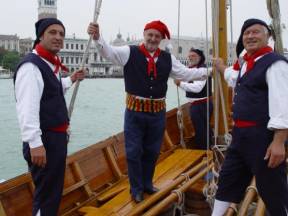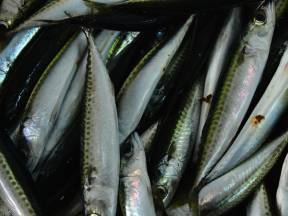Their routes

Beaches
From pebble coves sheltered by pine forests to sunny stone terraces with crystal clear sea - there are beaches here for every taste. Some are ideal for family vacations and carefree swimming, while others offer peace and solitude far from the crowds. A special atmosphere is created by hidden coves that can only be reached on foot or by boat, where the sea takes on the most beautiful shades of blue.

Fisherman's legacy and the light of the underworld
Komiža and Biševo preserve the unique heritage of the Adriatic – from natural wonders to cultural and historical monuments. The Blue and Medvidina caves bear witness to the beauty and power of the sea, while the Komuna Castle and the Fisherman’s Museum tell the story of centuries-old fishing tradition and the unique falkuša boats. The fortified monastery and church of St. Nicholas, known as Muster, have been the spiritual and defensive center of Komiža for centuries, and special rituals are still held there today. In the 20th century, fishing skills turned into industry – fish processing factories and the legendary Neptune have fed Komiža for more than a century. All these stories together form a mosaic of life in which the sea, faith and work have shaped the identity of this place.

Historical events
Located on the western part of the island of Vis, Komiža has grown for centuries along the sea, which has shaped its identity and everyday life. From the first records in the 16th century, through the immigration of families fleeing the Ottoman threat, to the fishing industry that has become the trademark of the place – history is intertwined with the sea and people. The visit of Pope Alexander III in 1177 is particularly memorable, when this was the first Croatian place visited by a pope. Legends such as the Route of Diomedes and archaeological traces testify to the thousand-year continuity of life and navigation, while tradition and nature preserve the story of the coexistence of man and the sea.

Sacred heritage
On the islands of Vis, Biševo and Sveca, churches have been preserved that testify to the millennial presence of Christianity and the Benedictine order in this part of the Adriatic. The Church of Our Lady of Planica on Vis, with its rare circular shape, is reminiscent of the Church of St. Donatus in Zadar, while on Sveca, the small church of St. Andrew has been preserved – the remains of a former Benedictine monastery from the 13th century. On Biševo, in the settlement of Polje, there is the Church of St. Sylvester, built in the mid-11th century, known for the Madonna of Biševo, one of the oldest images of the Virgin Mary in Dalmatia. These valuable monuments of culture and religion, today protected cultural properties, connect the islands into a unique historical and spiritual whole.

Cultural heritage and tradition
In Komiža, the sea is not just a space but also a destiny. For centuries, the people of Komiža lived alongside it and from it, carrying both its gifts and its dangers. Their lives were shaped by the ships they built, the language they spoke and the customs with which they invoked protection from heaven. Thus, a unique heritage was created – a combination of faith, knowledge and courage that still forms the heart of Komiža today. The fishermen and their boats were watched over by Saint Nicholas, the patron saint of travelers and the city, to whom they burned an old ship every winter as a sign of gratitude and prayer for the salvation of all others. From the need to survive on the high seas, the falkuša was born – a ship that hides two souls and which made the people of Komiža the first fishermen of the open sea. And in order to pass on all this knowledge, a special lingua halieutica developed, a fishermen's language intertwined with words about the sea, wind and catch. These are all threads of the same story – stories about Komiža, which for centuries has known how to love, respect and outwit the sea. Stories that today are not just memories, but living heritage, recognized and protected, and proudly carried into the future.

Komiža fishermen - conquerors of the world's seas
From the small town of Komiža, a fishing village on the island of Vis, came people who have left their mark on the world's fishing history. Nikola Martinis - Fishman was the first to bring the spirit of innovation to America, creating the foundations of modern fishing. His fellow countryman Paul Martinis made his name in the cold waters of Alaska and the Aleutians, where he became the legendary "Salmon King", personally decorated by American President Eisenhower. Ivan Žuanić, an immigrant to Washington at the beginning of the 20th century, began building a fleet in San Pedro that would grow into the largest fishing force in the world, and his heirs turned the family tradition into the powerful "Zi Company". The pinnacle of this dynasty is Lawrence Zuanich, who in the 1980s commanded a fleet of thirteen tuna vessels and annually caught one hundred thousand tons of tuna - as much as thirty-fifths of the world's catch. His most loyal collaborator was Ante Dundov Kongo with his Kaljani, without whom this fishing empire would not have been possible. From Fishman to the Salmon King, from San Pedro to Guam, the people of Komiža have shown with their knowledge, courage, and tireless work that even a small town can produce the world's greatest fishermen.

Surrounding islands
In the middle of the blue Adriatic, far from the mainland, four islands of special power and stories emerge from the sea. Svetac, once a lively fishing island, preserves the memory of life in harsh conditions and the struggle of man with the sea. Brusnik and Jabuka, born from fire, are unique in their magmatic origin and black rocks that protrude from the open sea like sculptures. Brusnik slowly "grows" from the sea, while Jabuka, resembling a black pyramid, defies everything, offering no shelter to a single ship. The most distant and largest of them, Palagruža, has been a landmark for sailors for centuries, a mythical place of ancient stories and the scene of numerous shipwrecks. These islands are not just geographical points on the map - they are natural monuments, witnesses of geological processes, fishing ventures and maritime legends. Each of them tells a different story, and together they form a unique whole - the black pearls of the open sea, the precious heritage of the Adriatic.

Traditional Komiža dishes
Dalmatian cuisine has always been a combination of sea, land and simple ingredients that are transformed into dishes rich in flavor and story. It smells of the sea in brudet, the warmth of home in Komiža pogača and the sweet festivity in Komiža cviti. Brudet is a dish of fishermen and farmers, born from the need to turn every catch into a delicious meal, while Komiža pogača speaks of togetherness and work around the table, when the dough is filled with salted sardines, onions and tomatoes. Cviti, on the other hand, bring a festive tone, because these crispy cookies are baked on special occasions and passed down from generation to generation as a sign of care and love. Together, the three recipes reveal the spirit of the island and the coast: simplicity, modesty, but also the richness of flavor that is created when tradition and nature come together on a plate.

Local events and festivals
Komiža lives through a series of events that combine tradition, togetherness and love for the sea. The Biševo Trail connects sport and nature, and the Children's Kalanko Festival brings joy to the youngest through play and creativity. Fisherman's Night and Biševo Night celebrate the centuries-old fishing spirit and island customs, while Zalogaj velikog mora brings the entire island together around gastronomy, music and socializing. A special place is occupied by Rota Palagružona, the oldest regatta in Europe, which preserves the memory of the brave fishermen of Komiža and their maritime heritage. Together, these events create a unique story about the identity, tradition and life of the island of Vis.
